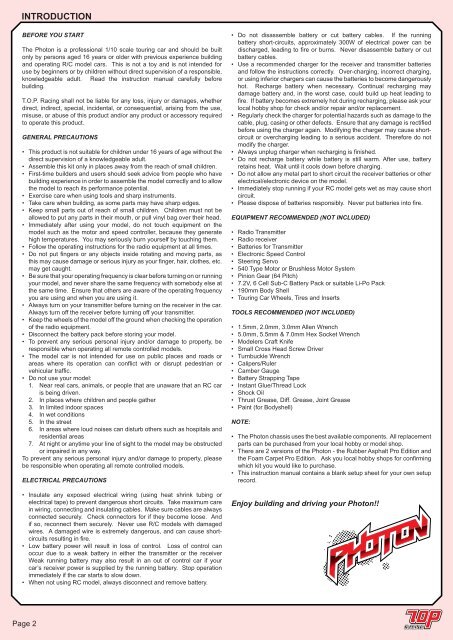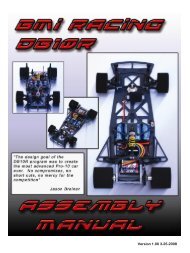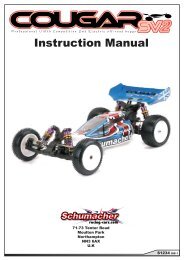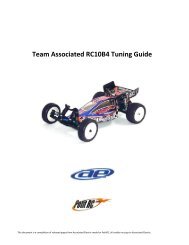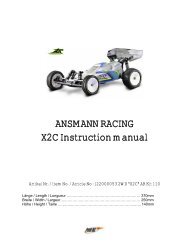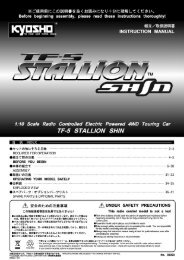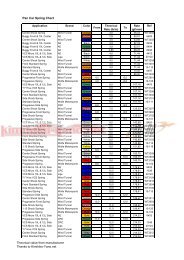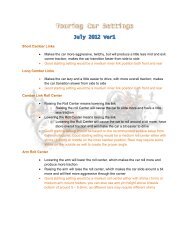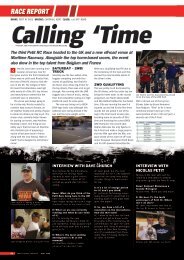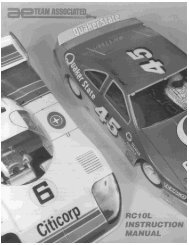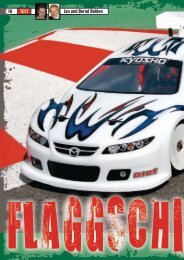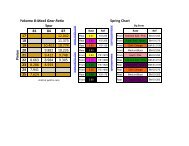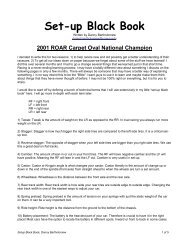INSTRUCTION MANUAL
INSTRUCTION MANUAL
INSTRUCTION MANUAL
You also want an ePaper? Increase the reach of your titles
YUMPU automatically turns print PDFs into web optimized ePapers that Google loves.
INTRODUCTION<br />
BEFORE YOU START<br />
The Photon is a professional 1/10 scale touring car and should be built<br />
only by persons aged 16 years or older with previous experience building<br />
and operating R/C model cars. This is not a toy and is not intended for<br />
use by beginners or by children without direct supervision of a responsible,<br />
knowledgeable adult. Read the instruction manual carefully before<br />
building.<br />
T.O.P. Racing shall not be liable for any loss, injury or damages, whether<br />
direct, indirect, special, incidental, or consequential, arising from the use,<br />
misuse, or abuse of this product and/or any product or accessory required<br />
to operate this product.<br />
GENERAL PRECAUTIONS<br />
• This product is not suitable for children under 16 years of age without the<br />
direct supervision of a knowledgeable adult.<br />
• Assemble this kit only in places away from the reach of small children.<br />
• First-time builders and users should seek advice from people who have<br />
building experience in order to assemble the model correctly and to allow<br />
the model to reach its performance potential.<br />
• Exercise care when using tools and sharp instruments.<br />
• Take care when building, as some parts may have sharp edges.<br />
• Keep small parts out of reach of small children. Children must not be<br />
allowed to put any parts in their mouth, or pull vinyl bag over their head.<br />
• Immediately after using your model, do not touch equipment on the<br />
model such as the motor and speed controller, because they generate<br />
high temperatures. You may seriously burn yourself by touching them.<br />
• Follow the operating instructions for the radio equipment at all times.<br />
• Do not put fi ngers or any objects inside rotating and moving parts, as<br />
this may cause damage or serious injury as your fi nger, hair, clothes, etc.<br />
may get caught.<br />
• Be sure that your operating frequency is clear before turning on or running<br />
your model, and never share the same frequency with somebody else at<br />
the same time. Ensure that others are aware of the operating frequency<br />
you are using and when you are using it.<br />
• Always turn on your transmitter before turning on the receiver in the car.<br />
Always turn off the receiver before turning off your transmitter.<br />
• Keep the wheels of the model off the ground when checking the operation<br />
of the radio equipment.<br />
• Disconnect the battery pack before storing your model.<br />
• To prevent any serious personal injury and/or damage to property, be<br />
responsible when operating all remote controlled models.<br />
• The model car is not intended for use on public places and roads or<br />
areas where its operation can confl ict with or disrupt pedestrian or<br />
vehicular traffi c.<br />
• Do not use your model:<br />
1. Near real cars, animals, or people that are unaware that an RC car<br />
is being driven.<br />
2. In places where children and people gather<br />
3. In limited indoor spaces<br />
4. In wet conditions<br />
5. In the street<br />
6. In areas where loud noises can disturb others such as hospitals and<br />
residential areas<br />
7. At night or anytime your line of sight to the model may be obstructed<br />
or impaired in any way.<br />
To prevent any serious personal injury and/or damage to property, please<br />
be responsible when operating all remote controlled models.<br />
ELECTRICAL PRECAUTIONS<br />
• Insulate any exposed electrical wiring (using heat shrink tubing or<br />
electrical tape) to prevent dangerous short circuits. Take maximum care<br />
in wiring, connecting and insulating cables. Make sure cables are always<br />
connected securely. Check connectors for if they become loose. And<br />
if so, reconnect them securely. Never use R/C models with damaged<br />
wires. A damaged wire is extremely dangerous, and can cause shortcircuits<br />
resulting in fi re.<br />
• Low battery power will result in loss of control. Loss of control can<br />
occur due to a weak battery in either the transmitter or the receiver<br />
Weak running battery may also result in an out of control car if your<br />
car’s receiver power is supplied by the running battery. Stop operation<br />
immediately if the car starts to slow down.<br />
• When not using RC model, always disconnect and remove battery.<br />
• Do not disassemble battery or cut battery cables. If the running<br />
battery short-circuits, approximately 300W of electrical power can be<br />
discharged, leading to fi re or burns. Never disassemble battery or cut<br />
battery cables.<br />
• Use a recommended charger for the receiver and transmitter batteries<br />
and follow the instructions correctly. Over-charging, incorrect charging,<br />
or using inferior chargers can cause the batteries to become dangerously<br />
hot. Recharge battery when necessary. Continual recharging may<br />
damage battery and, in the worst case, could build up heat leading to<br />
fi re. If battery becomes extremely hot during recharging, please ask your<br />
local hobby shop for check and/or repair and/or replacement.<br />
• Regularly check the charger for potential hazards such as damage to the<br />
cable, plug, casing or other defects. Ensure that any damage is rectifi ed<br />
before using the charger again. Modifying the charger may cause shortcircuit<br />
or overcharging leading to a serious accident. Therefore do not<br />
modify the charger.<br />
• Always unplug charger when recharging is fi nished.<br />
• Do not recharge battery while battery is still warm. After use, battery<br />
retains heat. Wait until it cools down before charging.<br />
• Do not allow any metal part to short circuit the receiver batteries or other<br />
electrical/electronic device on the model.<br />
• Immediately stop running if your RC model gets wet as may cause short<br />
circuit.<br />
• Please dispose of batteries responsibly. Never put batteries into fi re.<br />
EQUIPMENT RECOMMENDED (NOT INCLUDED)<br />
• Radio Transmitter<br />
• Radio receiver<br />
• Batteries for Transmitter<br />
• Electronic Speed Control<br />
• Steering Servo<br />
• 540 Type Motor or Brushless Motor System<br />
• Pinion Gear (64 Pitch)<br />
• 7.2V, 6 Cell Sub-C Battery Pack or suitable Li-Po Pack<br />
• 190mm Body Shell<br />
• Touring Car Wheels, Tires and Inserts<br />
TOOLS RECOMMENDED (NOT INCLUDED)<br />
• 1.5mm, 2.0mm, 3.0mm Allen Wrench<br />
• 5.0mm, 5.5mm & 7.0mm Hex Socket Wrench<br />
• Modelers Craft Knife<br />
• Small Cross Head Screw Driver<br />
• Turnbuckle Wrench<br />
• Calipers/Ruler<br />
• Camber Gauge<br />
• Battery Strapping Tape<br />
• Instant Glue/Thread Lock<br />
• Shock Oil<br />
• Thrust Grease, Diff. Grease, Joint Grease<br />
• Paint (for Bodyshell)<br />
NOTE:<br />
• The Photon chassis uses the best available components. All replacement<br />
parts can be purchased from your local hobby or model shop.<br />
• There are 2 versions of the Photon - the Rubber Asphalt Pro Edition and<br />
the Foam Carpet Pro Edition. Ask you local hobby shops for confi rming<br />
which kit you would like to purchase.<br />
• This instruction manual contains a blank setup sheet for your own setup<br />
record.<br />
Enjoy building and driving your Photon!!<br />
Page 2


